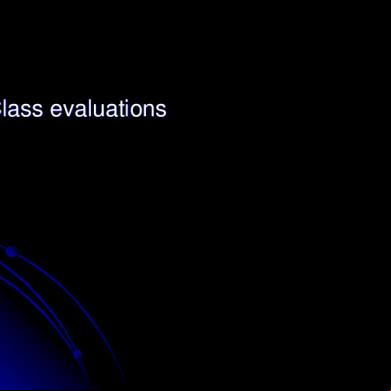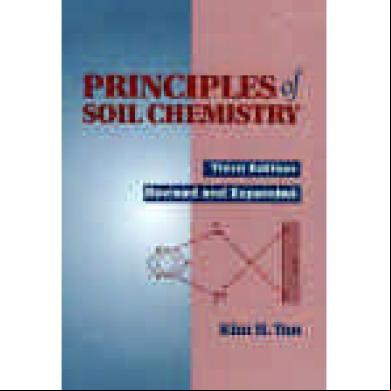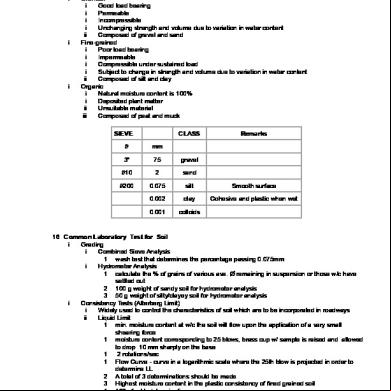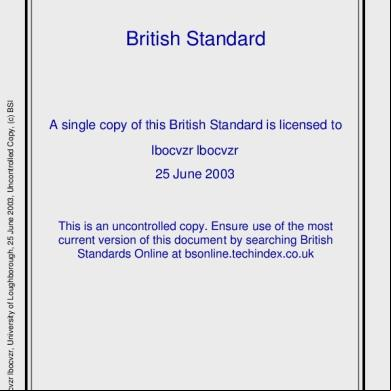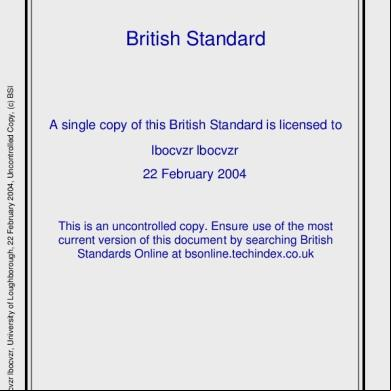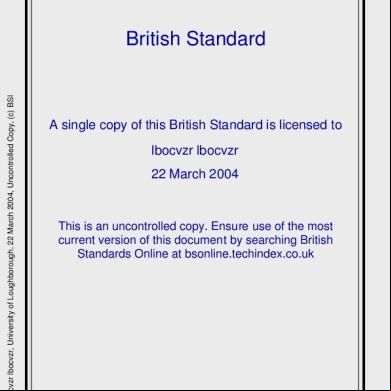Soil Chemistry 612q5l
This document was ed by and they confirmed that they have the permission to share it. If you are author or own the copyright of this book, please report to us by using this report form. Report 3b7i
Overview 3e4r5l
& View Soil Chemistry as PDF for free.
More details w3441
- Words: 807
- Pages: 30
Class evaluations
Soil Chemistry
Ion Exchange
Ions adsorbed to soil surfaces can be exchanged with ions in soil solution.
Cations and anions
Ion exchange
Organic colloids and inorganic micelles (clays) are sites of ion exchange
Where do ions in soil come from? Release
from organic matter
Rain Weathering
of parent material
Ion exchange
Exchangeable cations (on soil surfaces) cannot be removed by leaching.
Soluble cations (in solution) can be removed by leaching.
When soil is dried… …exchangeable cations hold to adsorption sites on soil surfaces. …soluble cations (and anions) precipitate or crystallize as salts.
Examples of soluble cations precipitating
Ion exchange Exchangeable ions on soil surface trading places with ions in solution.
On soil surfaces, there are: Exchangeable and Nonexchangeable Ions : Exchangeable: weakly held, in with soil solution, ready for quick replacement. “outer sphere complex” Nonexchangeable: “inner sphere complex” adsorbed by strong bonds or held in inaccessible places
(e.g., the K+ between layers of illite)
not part of ion exchange !
Cation exchange capacity (CEC) Sum total of exchangeable cations that a soil can adsorb. ( prevents nutrients from leaching away from roots)
CEC Expressed in: milliequivalents per 100 g (meq/100g)
Base saturation % of exchange sites occupied by basic cations Basic cations are cations other than H+ and Al+3 Base saturation + H+ ion saturation should equal 100%
For midwest US soils Notice neutral pH (7.0) requires a base sat of 80%. (neutral pH is not 50% because most base cations have a + charge of 2)
equilibrium Strive for equivalent proportions of solution and exchangeable ions. Upset equilibrium by: removal by plants leaching fertilization weathering
Initiate ion exchange
Ion exchange example: Add H+ ions to soil :
Ca+
Ca+
H+ Ca+
H+ +
Ca+ Ca+
soil Ca+
exchangeable
Ca+ Ca+
Ca+
H+ H+ solution
solution
H+
Ca+ Ca+ +
H+
Ca+ H+
H+ Ca+
Ca+
Ca+
Ca+
exchangeable
solution
Rules of ion exchange
Process is Reversible
Charge by charge basis
Ratio Law:
ratio of exchangeable cations will be same as ratio of solution cations
Add K fertilizer…
K+
Ca+2 + Ca+2
K+
Ca+2
K+
Ca+2 +
K+
K+
K+
K+ K+
1 Ca : 2 K
1 Ca : 2 K Same ratio
Energy of adsorption Strong --------------------------------------Weak Al+3 > Ca+2 > Mg+2 > [K+ = NH4+ ] > Na+ > H+ (based on charge and hydrated radius)
Soil pH importance
Determines solubility of nutrients
Before plants can get nutrients, they must be dissolved in soil solution
Microbial activity also depends on pH
pH negative log of the hydrogen ion concentration (also a measure of OH- concentration) If H+ concentration > OH- : acidic If OH- > H+ : basic Soil pH is pH of solution, NOT exchange complex
General soil pH conditions: “Slightly acid” 6.0 – 6.6
“Slightly basic” 7.4 – 8.0
“Moderately acid” 5.0 – 6.0
“Moderately basic” 8.0 – 9.0
“Strongly acid” < 5.0
“Strongly basic” > 9.0
In soil, both H+ and Al+3 ions produce acidity Al+3 produces H+ ions when it reacts with water. (when pH below 6: Al+3 is the cause of acidity)
Causes of soil basicity
1.
2.
Hydrolysis of basic cations Hydrolysis of carbonates
1. Hydrolysis of basic cations: (especially Ca+2, Mg+2, K+, NH4+, Na+)
(also called exchangeable bases) Extent to which exchangeable bases will hydrolyze depends on ability to compete with H+ ions for exchange sites. Na
Na
Na Na
Na
Na
+
Na
H2O
H Na
Na
+
Na
+ OH-
K+ and Na+ are weakly held compared to Ca+2 and Mg+2. Recall
energy of adsorption
So, K+ and Na+ are hydrolyzed easily and yield higher pHs .
2. Hydrolysis of carbonates (especially CaCO3, MgCO3, Na2CO3)
•
As long as there are carbonates in the soil, carbonate hydrolysis controls pH. •
•
Calcareous soils remain alkaline because H+ ions combine with OH- to form H2O. For those soils to become acid, all carbonates must be leached. •
Basic cations replaced by Al+3 and H+
CaCO3 + H2O Na2CO3 + H2O
Ca+2 + HCO3- + OHNa + HCO3- + OH- (higher pH because Na more soluble)
Causes of soil acidity
1. 2.
Accumulation of soluble acids Exchangeable acids (Al+3, H+)
1. Accumulation of soluble acids at faster rate than they can be neutralized or removed a.
Carbonic acid (respiration and atmospheric CO2)
b. Mineralization of organic matter (produces organic, nitric, sulfuric acids) Precipitation increases both a and b
2. Exchangeable acids Exch. H+ or Al+3 dissociate Al+3 ties up OH- from water, releases an equivalent amount of H+ ions.
Al+3 + H2O
AlOH+2 + H+
CEC and pH Only 2:1 silicate clays do not have pH-dependent CECs. Others are pH-dependent: 1:1 kaolinite: low pH: low CEC high pH: high CEC
Oxidic clays
Class evaluations
Soil Chemistry
Ion Exchange
Ions adsorbed to soil surfaces can be exchanged with ions in soil solution.
Cations and anions
Ion exchange
Organic colloids and inorganic micelles (clays) are sites of ion exchange
Where do ions in soil come from? Release
from organic matter
Rain Weathering
of parent material
Ion exchange
Exchangeable cations (on soil surfaces) cannot be removed by leaching.
Soluble cations (in solution) can be removed by leaching.
When soil is dried… …exchangeable cations hold to adsorption sites on soil surfaces. …soluble cations (and anions) precipitate or crystallize as salts.
Examples of soluble cations precipitating
Ion exchange Exchangeable ions on soil surface trading places with ions in solution.
On soil surfaces, there are: Exchangeable and Nonexchangeable Ions : Exchangeable: weakly held, in with soil solution, ready for quick replacement. “outer sphere complex” Nonexchangeable: “inner sphere complex” adsorbed by strong bonds or held in inaccessible places
(e.g., the K+ between layers of illite)
not part of ion exchange !
Cation exchange capacity (CEC) Sum total of exchangeable cations that a soil can adsorb. ( prevents nutrients from leaching away from roots)
CEC Expressed in: milliequivalents per 100 g (meq/100g)
Base saturation % of exchange sites occupied by basic cations Basic cations are cations other than H+ and Al+3 Base saturation + H+ ion saturation should equal 100%
For midwest US soils Notice neutral pH (7.0) requires a base sat of 80%. (neutral pH is not 50% because most base cations have a + charge of 2)
equilibrium Strive for equivalent proportions of solution and exchangeable ions. Upset equilibrium by: removal by plants leaching fertilization weathering
Initiate ion exchange
Ion exchange example: Add H+ ions to soil :
Ca+
Ca+
H+ Ca+
H+ +
Ca+ Ca+
soil Ca+
exchangeable
Ca+ Ca+
Ca+
H+ H+ solution
solution
H+
Ca+ Ca+ +
H+
Ca+ H+
H+ Ca+
Ca+
Ca+
Ca+
exchangeable
solution
Rules of ion exchange
Process is Reversible
Charge by charge basis
Ratio Law:
ratio of exchangeable cations will be same as ratio of solution cations
Add K fertilizer…
K+
Ca+2 + Ca+2
K+
Ca+2
K+
Ca+2 +
K+
K+
K+
K+ K+
1 Ca : 2 K
1 Ca : 2 K Same ratio
Energy of adsorption Strong --------------------------------------Weak Al+3 > Ca+2 > Mg+2 > [K+ = NH4+ ] > Na+ > H+ (based on charge and hydrated radius)
Soil pH importance
Determines solubility of nutrients
Before plants can get nutrients, they must be dissolved in soil solution
Microbial activity also depends on pH
pH negative log of the hydrogen ion concentration (also a measure of OH- concentration) If H+ concentration > OH- : acidic If OH- > H+ : basic Soil pH is pH of solution, NOT exchange complex
General soil pH conditions: “Slightly acid” 6.0 – 6.6
“Slightly basic” 7.4 – 8.0
“Moderately acid” 5.0 – 6.0
“Moderately basic” 8.0 – 9.0
“Strongly acid” < 5.0
“Strongly basic” > 9.0
In soil, both H+ and Al+3 ions produce acidity Al+3 produces H+ ions when it reacts with water. (when pH below 6: Al+3 is the cause of acidity)
Causes of soil basicity
1.
2.
Hydrolysis of basic cations Hydrolysis of carbonates
1. Hydrolysis of basic cations: (especially Ca+2, Mg+2, K+, NH4+, Na+)
(also called exchangeable bases) Extent to which exchangeable bases will hydrolyze depends on ability to compete with H+ ions for exchange sites. Na
Na
Na Na
Na
Na
+
Na
H2O
H Na
Na
+
Na
+ OH-
K+ and Na+ are weakly held compared to Ca+2 and Mg+2. Recall
energy of adsorption
So, K+ and Na+ are hydrolyzed easily and yield higher pHs .
2. Hydrolysis of carbonates (especially CaCO3, MgCO3, Na2CO3)
•
As long as there are carbonates in the soil, carbonate hydrolysis controls pH. •
•
Calcareous soils remain alkaline because H+ ions combine with OH- to form H2O. For those soils to become acid, all carbonates must be leached. •
Basic cations replaced by Al+3 and H+
CaCO3 + H2O Na2CO3 + H2O
Ca+2 + HCO3- + OHNa + HCO3- + OH- (higher pH because Na more soluble)
Causes of soil acidity
1. 2.
Accumulation of soluble acids Exchangeable acids (Al+3, H+)
1. Accumulation of soluble acids at faster rate than they can be neutralized or removed a.
Carbonic acid (respiration and atmospheric CO2)
b. Mineralization of organic matter (produces organic, nitric, sulfuric acids) Precipitation increases both a and b
2. Exchangeable acids Exch. H+ or Al+3 dissociate Al+3 ties up OH- from water, releases an equivalent amount of H+ ions.
Al+3 + H2O
AlOH+2 + H+
CEC and pH Only 2:1 silicate clays do not have pH-dependent CECs. Others are pH-dependent: 1:1 kaolinite: low pH: low CEC high pH: high CEC
Oxidic clays
